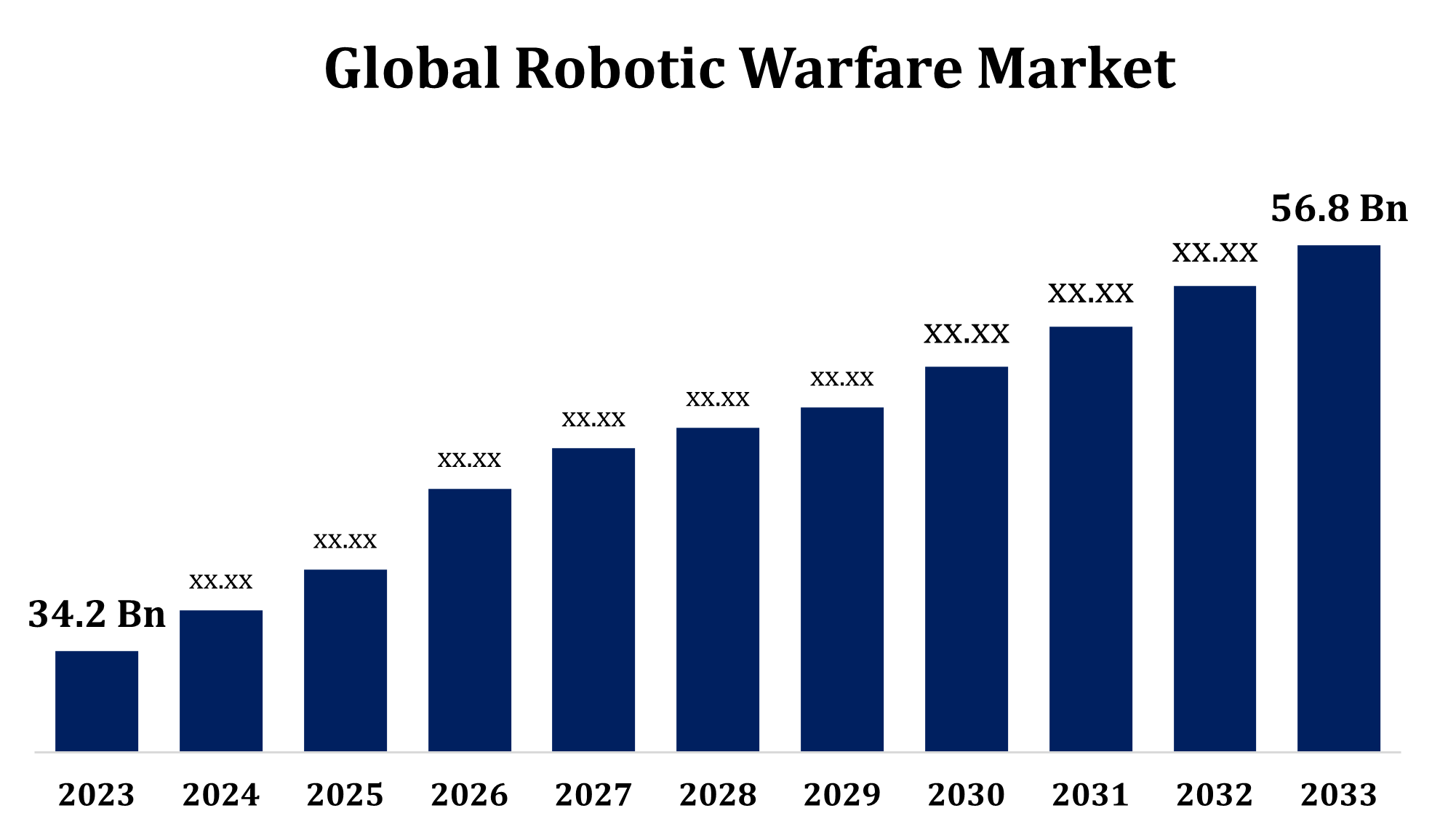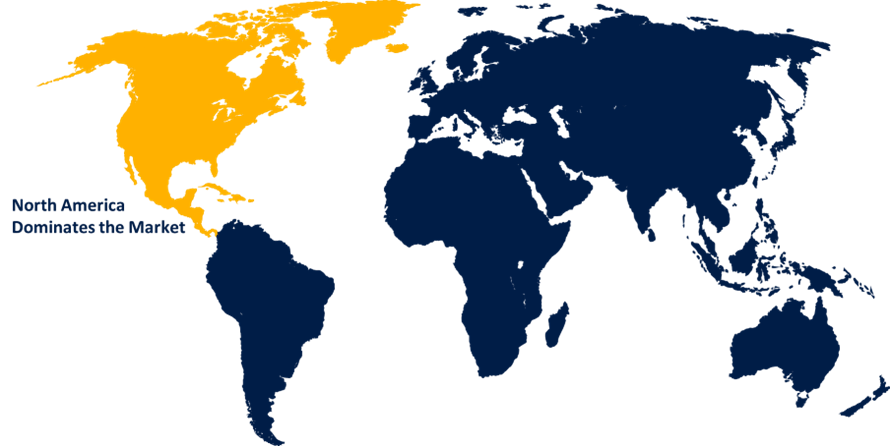Global Robotic Warfare Market Size To Worth USD 56.8 Billion By 2033 | CAGR of 5.20%
Category: Aerospace & DefenseGlobal Robotic Warfare Market Size To Worth USD 56.8 Billion By 2033
According to a research report published by Spherical Insights & Consulting, the Global Robotic Warfare Market Size to grow from USD 34.2 billion in 2023 to USD 56.8 Billion by 2033, at a Compound Annual Growth Rate (CAGR) of 5.20% during the forecast period.

Get more details on this report -
Browse key industry insights spread across 251 pages with 125 Market data tables and figures & charts from the report on the "Global Robotic Warfare Market Size, Share, and COVID-19 Impact Analysis, By Mode of Operation (Autonomous and Semi Autonomous), By Capability (Unmanned platforms & systems, Exoskeleton & wearables, Target acquisition systems, and Turret and weapon systems), By Application (Intelligence, Surveillance and Reconnaissance, Logistics and Support, Search and Rescue, Combat and Operations, Tracking and Targeting, and Training and Simulation), and By Region (North America, Europe, Asia-Pacific, Latin America, Middle East, and Africa), Analysis and Forecast 2023 - 2033." Get Detailed Report Description Here: https://www.sphericalinsights.com/reports/robotic-warfare-market
The robotic warfare market has experienced substantial growth, fueled by advancements in robotics, artificial intelligence (AI), and automation technologies. Military forces around the world are increasingly adopting unmanned ground vehicles (UGVs), unmanned aerial vehicles (UAVs), and robotic systems for tasks such as surveillance, reconnaissance, combat, and logistics. These technologies provide improved precision, reduced risk to human life, and enhanced operational efficiency. The demand for autonomous systems capable of handling complex tasks in dynamic, hazardous environments further accelerates market growth. Governments are making significant investments in defense robotics to maintain a competitive edge. Key drivers of this expansion include advancements in AI, machine learning, and sensor technologies, as well as rising defense budgets. Despite this, ethical concerns and regulatory challenges remain key obstacles. The market is expected to evolve with continued innovations in autonomy and system integration.
Robotic Warfare Market Value Chain Analysis
The robotic warfare market value chain consists of multiple stages, starting from research and development to final deployment. Initially, companies focus on R&D to create advanced robotic systems, integrating artificial intelligence (AI), machine learning, and sensor technologies. The next phase is manufacturing, where components such as drones, sensors, and control systems are produced by hardware manufacturers and component suppliers. After manufacturing, the systems undergo rigorous testing and integration to ensure they are compatible with military platforms and comply with defense standards. Once validated, the systems are deployed for operational use by armed forces. Post-deployment, continuous maintenance, software updates, and performance monitoring are essential to maintain optimal system functionality. The value chain is shaped by factors such as defense budgets, technological progress, and government regulations.
Robotic Warfare Market Opportunity Analysis
The robotic warfare market offers substantial opportunities, driven by technological innovations and growing defense demands. The increasing use of unmanned aerial vehicles (UAVs), unmanned ground vehicles (UGVs), and autonomous robotic systems presents significant growth potential. A key opportunity lies in the development of AI-driven systems that improve decision-making, precision, and efficiency in combat, while also reducing human casualties and operational costs. The demand for advanced robotic systems in surveillance, reconnaissance, logistics, and combat is expanding, particularly in nations modernizing their military capabilities. Moreover, rising defense budgets and greater investment in research and development open up avenues for market innovation. Collaborations between tech companies and defense contractors, along with government funding, further accelerate opportunities. While regulatory challenges and ethical concerns remain, the market is on track for substantial growth.
The increasing research and adoption of robotic systems in modern warfare are driving substantial growth in the robotic warfare market. Military forces are progressively deploying advanced unmanned aerial vehicles (UAVs), unmanned ground vehicles (UGVs), and autonomous systems for tasks such as surveillance, reconnaissance, logistics, and combat. These technologies provide enhanced precision, real-time decision-making, and reduced human involvement, leading to improved operational efficiency and safety. Ongoing advancements in artificial intelligence (AI), machine learning, and sensor technologies are further advancing autonomous systems. As nations modernize their defense capabilities, the demand for cutting-edge robotic systems rises, prompting significant investments in research, development, and procurement. This trend is expected to continue, ensuring robust growth for the market in the years ahead.
A major concern in the robotic warfare market is the ethical implications of deploying autonomous systems in combat, especially regarding machine-driven decision-making that may result in unintended consequences or loss of life. Regulatory challenges are also significant, as international laws and norms surrounding the use of robotic systems in warfare are still being developed. Moreover, the high costs of developing and procuring advanced robotic systems may restrict access for nations with smaller defense budgets. Technological limitations, such as the reliability of autonomous systems in complex and unpredictable environments, and cybersecurity vulnerabilities, present additional barriers. Lastly, the integration of these systems into existing military infrastructure and ensuring their compatibility with human-operated systems remain critical challenges to address.
Insights by Mode of Operation
The semi autonomous segment accounted for the largest market share over the forecast period 2023 to 2033. Semi-autonomous robots are designed to operate with a high level of independence while still allowing for human intervention when necessary, making them suitable for missions where full autonomy might not be practical or desirable. This segment includes unmanned aerial vehicles (UAVs), unmanned ground vehicles (UGVs), and robotic combat systems that can carry out tasks such as surveillance, reconnaissance, and logistics with minimal human oversight. The growth of this segment is fueled by the rising demand for greater precision, efficiency, and reduced risks to personnel. Furthermore, advancements in artificial intelligence (AI), machine learning, and sensor technologies are improving the capabilities of semi-autonomous systems, making them more adaptable and dependable in complex combat situations.
Insights by Capability
The unmanned platforms & systems segment accounted for the largest market share over the forecast period 2023 to 2033. Unmanned platforms, such as unmanned aerial vehicles (UAVs), unmanned ground vehicles (UGVs), and unmanned maritime systems, play a crucial role in enhancing operational effectiveness in areas like surveillance, reconnaissance, combat, and logistics. The growing demand for these platforms is driven by their ability to function in hazardous environments, minimize human casualties, and improve mission efficiency. Advances in artificial intelligence (AI), autonomy, and sensor technologies are enhancing their performance, enabling more complex and data-driven operations. Additionally, the increasing need for real-time intelligence, surveillance, and precise strike capabilities is accelerating the adoption of unmanned systems. As military forces seek advanced, cost-effective solutions to address evolving security challenges, this segment is expected to see continued growth.
Insights by Application
The Intelligence, Surveillance and Reconnaissance segment accounted for the largest market share over the forecast period 2023 to 2033. The growth of the ISR segment is driven by the increasing demand for real-time data and improved situational awareness in modern combat. Robotic systems such as unmanned aerial vehicles (UAVs), unmanned ground vehicles (UGVs), and drones are being extensively adopted for ISR operations, allowing militaries to collect crucial intelligence without risking human lives. These platforms enable continuous surveillance, threat detection, and data collection for reconnaissance in both conventional and asymmetric warfare settings. Advancements in artificial intelligence (AI), machine learning, and sensor technologies are enhancing the precision and efficiency of ISR systems, enabling them to manage more complex missions. The rising need for better battlefield awareness and informed decision-making is expected to drive further growth in the ISR segment of the robotic warfare market.
Insights by Region

Get more details on this report -
North America is anticipated to dominate the Robotic Warfare Market from 2023 to 2033. The U.S. Department of Defense is placing significant emphasis on developing and deploying autonomous systems, such as unmanned aerial vehicles (UAVs), unmanned ground vehicles (UGVs), and robotic combat systems, to enhance military capabilities. Ongoing research and development in artificial intelligence (AI), robotics, and machine learning bolster the region's leadership in defense innovation. Additionally, Canada is also investing in defense robotics, further driving market growth. North America's robust defense infrastructure, along with strategic collaborations between government agencies and private companies, accelerates the technological advancements and deployment of robotic systems. The region's strong focus on modernization, combat readiness, and military superiority ensures the continued expansion of the robotic warfare market.
Asia Pacific is witnessing the fastest market growth between 2023 to 2033. China is leading the way in deploying advanced robotic technologies to strengthen its military capabilities. Furthermore, ongoing research and development in artificial intelligence (AI) and robotics are facilitating the quicker deployment of autonomous systems across the region. The growing demand for enhanced surveillance, reconnaissance, and combat capabilities, along with evolving security threats, is driving the market's expansion. Collaborations between governments and defense contractors are also crucial in accelerating the adoption of robotic warfare technologies in the region.
Recent Market Developments
- In March 2023, General Dynamics Corporation showcased a technology demonstration of their Tracked Robot 10-ton (TRX) at the U.S. Army's Force Symposium.
Major players in the market
- Aero Vironment, Inc.
- BAE Systems plc
- Autonomous Solutions, Inc. (ASI)
- Boeing
- General Atomics
- Northrop Grumman Corporation
- Cobham plc
- Dassault Group
- Elbit Systems Ltd.
- Textron Inc.
- Lockheed Martin Corporation
- Thales Group
Market Segmentation
This study forecasts revenue at global, regional, and country levels from 2023 to 2033.
Robotic Warfare Market, Mode of Operation Analysis
- Autonomous
- Semi Autonomous
Robotic Warfare Market, Capability Analysis
- Unmanned platforms & systems
- Exoskeleton & wearables
- Target acquisition systems
- Turret and weapon systems
Robotic Warfare Market, Application Analysis
- Intelligence, Surveillance and Reconnaissance
- Logistics and Support
- Search and Rescue
- Combat and Operations
- Tracking and Targeting
- Training and Simulation
Robotic Warfare Market, Regional Analysis
- North America
- US
- Canada
- Mexico
- Europe
- Germany
- Uk
- France
- Italy
- Spain
- Russia
- Rest of Europe
- Asia Pacific
- China
- Japan
- India
- South Korea
- Australia
- Rest of Asia Pacific
- South America
- Brazil
- Argentina
- Rest of South America
- Middle East & Africa
- UAE
- Saudi Arabia
- Qatar
- South Africa
- Rest of the Middle East & Africa
About the Spherical Insights & Consulting
Spherical Insights & Consulting is a market research and consulting firm which provides actionable market research study, quantitative forecasting and trends analysis provides forward-looking insight especially designed for decision makers and aids ROI.
Which is catering to different industry such as financial sectors, industrial sectors, government organizations, universities, non-profits and corporations. The company's mission is to work with businesses to achieve business objectives and maintain strategic improvements.
CONTACT US:
For More Information on Your Target Market, Please Contact Us Below:
Phone: +1 303 800 4326 (the U.S.)
Phone: +91 90289 24100 (APAC)
Email: inquiry@sphericalinsights.com, sales@sphericalinsights.com
Contact Us: https://www.sphericalinsights.com/contact-us
Need help to buy this report?